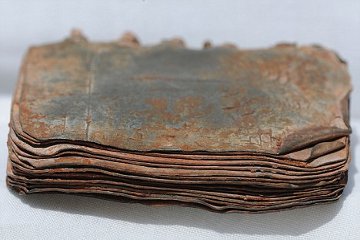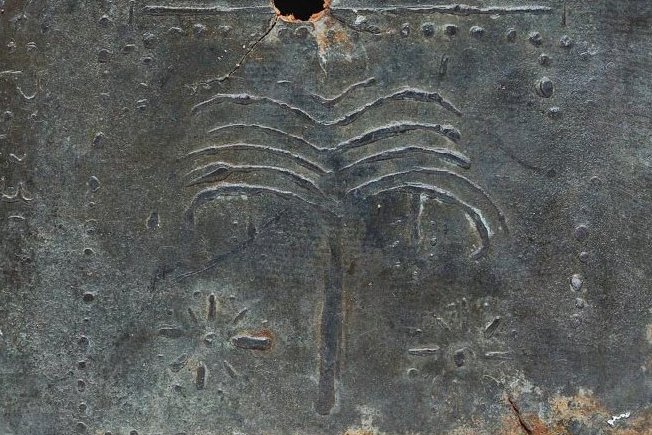Lead Books
There is a certain amount of excitement going around the internet at the moment over a collection of 70 "books" made of lead. Each "book" has between five and fifteen credit-card sized pages, held together along one edge by four or five metal rings, so the end result is like a modern spiral-bound book.
Nothing very much is known about the discovery of these "books". According to the story which is being told, they were discovered five or six years ago by Beduin shepherds whose sheep were grazing in a militarised zone in northern Jordan, near the village of Saham, which lies close tto the point where Syria, Jordan and Israel meet. Villagers from Saham say that a flash flood five years ago - in other words, around 2006 - uncovered what looked like a large millstone and when this was lifted or pushed sideways, the entrance to a cave was discovered. Inside the cave there were a number of niches, each of which contained one of the lead books. Also in the cave were some lead scrolls and other unspecified objects.
Today the books are in the possession of an Israeli Arab by the name of Hassan Saida, who lives in the village of Umm al-Ghanim at the foot of Mt Tabor. Hassan runs a haulage business and is considered wealthy in his community. He is a respectable married man with half a dozen children and he is vociferous in claiming that the "books" have been in his family for at least a century.
Mr Saida's business partner, on the other hand, is supposed to have been the person who drew Hassan's attention to the books, having been shown them while on a trip to Jordan. He bought two of the smallest ones and showed them to Hassan who became entranced by them and convinced that owning them would bring him good luck. He set out to acquire as many of them as possible.
He was aided by the fact that Israel and Jordan are now officially at peace. In previous years the only crossing point between the two countries was at the Allenby Bridge near Jericho, where stringent security measures made it virtually impossible for any vehicles other than diplomatic ones to pass from one country to the other. However since peace has been declared, a new crossing point has been opened up just south of Galilee and here things are far more relaxed.
Hassan's trucks make regular trips between Jordan and Israel and as his agents acquired the books - which range in size from credit card sized to almost A4 size, his truck drivers smuggled them into Israel. The smaller ones they wore around their necks like amulets and because nothing like them had ever been seen before, none of the border guards gave them a second glance: who cares what superstitions the Arabs practise?
The larger books were concealed behind dashboards and here, at least, I cannot unduly blame the guards for not investigating too thoroughly. Muslim fatalism holds that breakdowns are the will of Allah and have nothing to do with the neglect to maintain the vehicle. Repairs are haphazard, fuses are regularly replaced with fencing wire and burned out wires with more of the same. It would be a brave - or foolhardy - man indeed who needlessly groped around underneath a dashboard!
Unfortunately our Muslim friends are not noted for their unswerving fidelity to fact and both parties have excellent reasons for deviating from the truth. Any ancient objects found in Jordan are automatically the property of the state and there is not, as in European countries, a procedure for compensating the lucky finders. The shepherds, therefore, have good reason to transfer or sell them to their compatriot in Israel.
He, on the other hand, is aware that any antiquities found after 1972 are the property of the State of Israel - again, without compensation - so he too has good reason to claim that they have been in his family's ownership for a long period of time.
We now turn to the "books" themselves.
Writing on lead is not as odd as you might think. In a world without paper, anything that will hold an impression can be used for writing and some very odd substances indeed have been employed. Early versions of the Qur'an are said to have been jotted down on palm leaves; parchment is made of calf skins, papyrus of the sugary pith of reeds. Up in Vindolanda, on Hadrian's Wall, people exchanged notes written on thin, postcard sized pieces of wood.
Metal is less common. We know that Romans frequently wrote curses on strips of lead which were then rolled up and tossed into a fountain or spring where, presumably, they would continue to exert their baleful influence for as long as the lead lasted. Complete documents written on lead are much less common. The only metal documents to which I can find reference are monumental inscriptions which were intended for public display.

| |
| Each page is about the same size as a credit card, but slightly thicker and a good deal heavier! |
So far as I have been able to discover, there is no other example of a "book" made of metal and although the press release about this discovery talks grandly of the fact that Christians made the codex popular, preferring the portability and ease of use of separate pages bound together, over an unwieldy scroll, it is a considerable leap from a parchment or papyrus book to one made of metal!
Unfortunately, Mr Saida's ownership of the books is singularly uninformed. Although he values them highly and is said to have turned down offers of tens of millions of dollars for just a few of them, he handles them freely and, if they look a bit corroded, coats them in olive oil to preserve them! His efforts to open some of them have resulted in bent pages and possible damage
It is said that a Palestinian woman approached British journalist Nick Fielding about the books. She claimed that she was worried that they might disappear into the black market, but whether that was because she feared a loss of priceless heritage or because she was jealous that she wasn't getting a cut, is uncertain. After considerable bargaining, Nick was loaned two of the books and authorised to approach British museums with a view to getting a valuation.
Mr Fielding is said to have contacted the British Museum, the Cambridge FitzWilliam Museum, and other instutions, but none would even look at the objects, fearing that they had been illegally acquired. Interestingly, Mr Fielding obtained permission from the Israeli Antiquities Authority to take the books out of the country and the IAA, believing that the objects were forgeries, had no hesitation in granting him permission to do what he liked!
Eventually Nick Fielding commissioned private analysis from Dr Peter Northover at Cambridge University, a world-renowned expert on ancient metals. He confirmed that the lead was from the Middle East and that it was consistent with ancient Roman lead. Spectrographic and crystallographic analysis indicate that the patina on the lead is consistent with a date of around AD 100. So long as this conclusion is upheld, it would appear that the books are not a modern production - a forgery, in other words.
Despite this, it would appear that the first serious study of the "books" has been by a somewhat maverick scholar whose qualifications for that title are uncertain. He is the author of a book, In the Name of the Gods which I have not read and, if the blurb on the cover is anything to go by, am never likely to read. In part the blurb states:
Citing the relationships between the frequencies of the human brain in expanded state (7-13Hz) and the dominating frequency of planetary resonance (around 8Hz.). Elkington builds a case for an ancient science as the root of early religions and also of Christianity.
I am dubious about how many genuine scholars would regard "the dominating frequency of planetary resonance" as significant in the study of religion - even supposing that there is one single dominant resonance for both miniscule Mercury and gas-giant Jupiter!
According to Elkington and the pictures he has released, the pages appear to have been cast rather than written, for the signs and symbols are in relief on the surface of the lead. However although the letters are in an archaic form of Hebrew or Aramaic that was in use 200 BC - AD 100, they are all jumbled up and do not form words. Elkington suggests that they form some sort of code but neither he nor anyone else has proposed a solution to this code - if code it is.

| |
| The palm tree on the cover of this sealed lead book is supposed to be a symbol of the Messiah. |
"In the upper square of one of the book covers we have the seven-branch menorah, which Jews were utterly forbidden to represent because it resided in the holiest place in the Temple in the presence of God. So we have the coming of the messiah to approach the holy of holies - in other words to get legitimacy from God."

| |
| The eight-pointed stars below the palm tree are, it is claimed, another Messianic symbol. |
Again, I am not aware of this prohibition against representing the menorah - certainly there are menorahs to be found at Capernaum and Beth Shearim - and in any case the menorah did not stand in the Holy of Holies but in the first room of the Temple. A dubious claim supported by a factual inaccuracy does not seem a good basis for reaching startling conclusions.
In short, although these are early days and it would be rash to leap to conclusions before the objects have been examined by better qualified scholars than Mr Elkington, I am inclined to be sceptical. I fear that the inflated claims made about the "books" have more to do with hopes that the Jordanian government will stump up large sums of money to acquire them than with any objective and incontrovertible evidence of their worth.
© Kendall K. Down 2011





